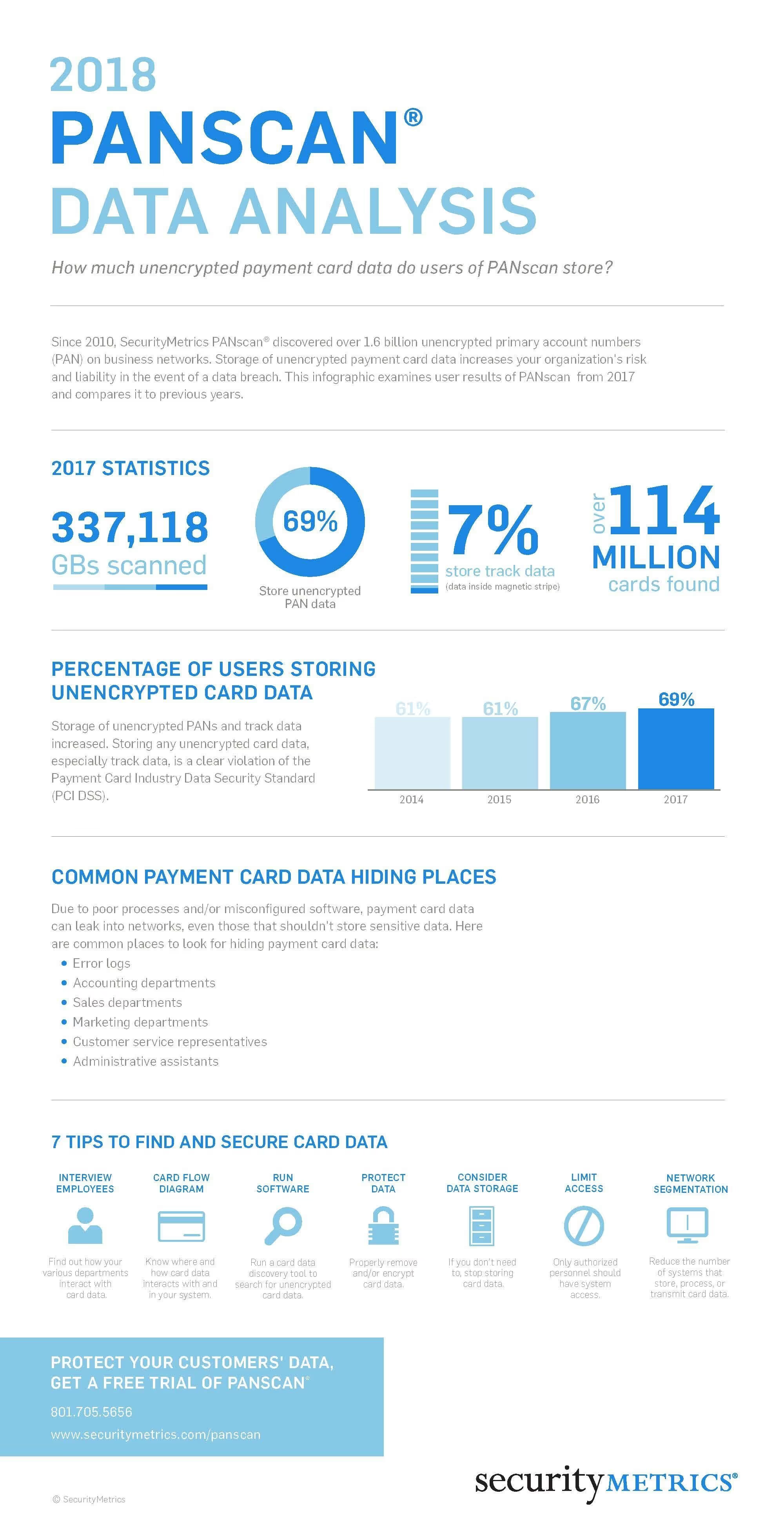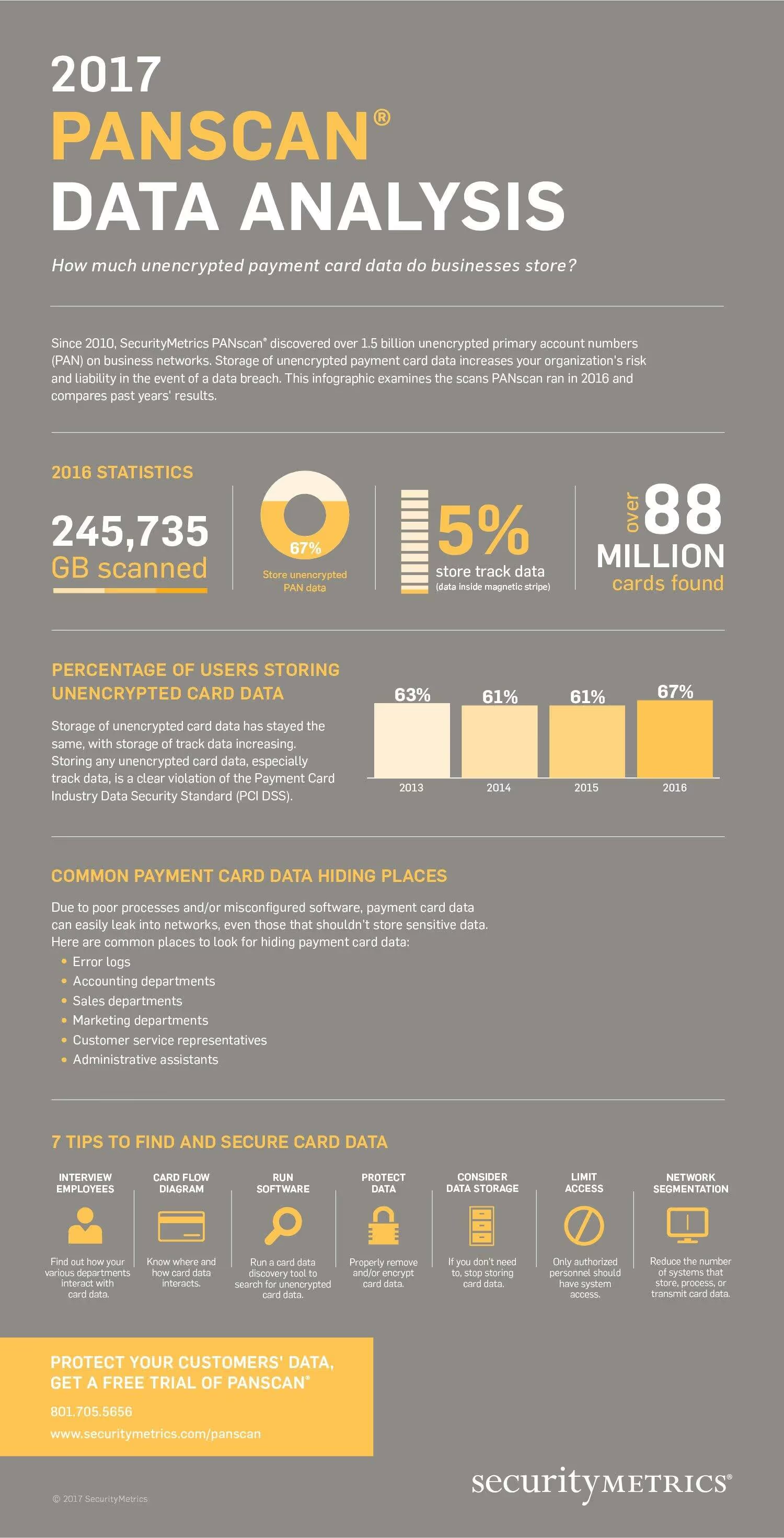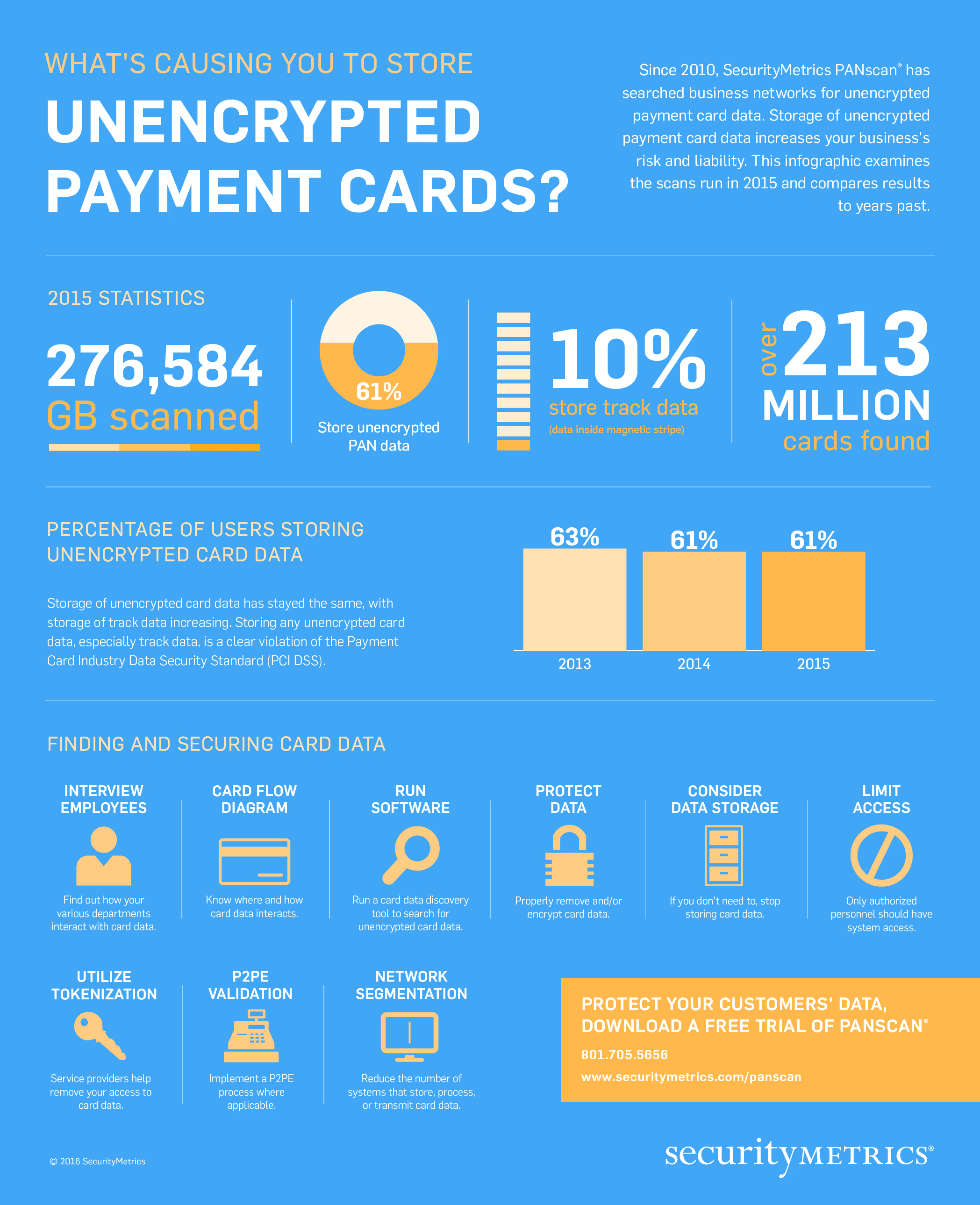PANscan Trends
See how you rank against other organizations and how they handle the storage of unencrypted payment card data over the years.
See how you rank against other organizations and how they handle the storage of unencrypted payment card data over the years.
SecurityMetrics PANscan® is a card data discovery tool that businesses use to search for unprotected credit card data and to help confirm their PCI DSS audit scope.
Using automated card data discovery tools helps businesses find primary account numbers (PAN) on computer systems, networks, hard drives, and attached storage devices. Many businesses experience compromise because simple steps are not taken to ensure security. PANscan is a simple tool that helps limit business liability.
Since 2010, SecurityMetrics PANscan® discovered over 3.1 billion unencrypted primary account numbers (PAN) on business networks. Storage of unencrypted payment card data increases your organization's risk and liability in the event of a data breach.
In 2024, the results of SecurityMetrics’ PANscan showed that of users scanned, 90% had unencrypted payment card data on their devices and system–adding up to over 114 million cards found. While a few results are false positives, many businesses have successfully used the tool to remove unencrypted card data unintentionally stored on devices and systems, which could have been vulnerable to data breaches, data theft, and data leaks.
The percentage of businesses that improperly stored PAN has usually gone up each year, starting at 61% in 2015, 67% in 2016, 69% in 2017, rising sharply in 2018 to 85%, 88% in 2019, but 2020 saw a slight decrease with 74% storing unencrypted PAN data, with the trend increasing again 77% in 2021, 86% in 2022, 84% in 2023, and 90% in 2024.
Alarmingly, 6% of businesses store magnetic full-track data, which is never permitted by the PCI DSS.
SecurityMetrics PANscan® is a card data discovery tool that businesses use to search for unprotected credit card data and to help confirm their PCI DSS audit scope.
Using automated card data discovery tools helps businesses find primary account numbers (PAN) on computer systems, networks, hard drives, and attached storage devices. Many businesses experience compromise because simple steps are not taken to ensure security. PANscan is a simple tool that helps limit business liability.
Since 2010, SecurityMetrics PANscan® has discovered over 3.1 billion unencrypted primary account numbers (PAN) on business networks. Storage of unencrypted payment card data increases your organization's risk and liability in the event of a data breach. This infographic examines user results of PANscan from 2023 and compares it to previous years.
2024 Statistics
Storing any unencrypted card data, especially track data, is a violation of the Payment Card Industry Data Security Standard (PCI DSS) and makes it easier for a criminal to steal data.
The majority of networks scanned do not adequately protect stored credit card numbers.
SecurityMetrics PANscan® is a card data discovery tool that businesses use to search for unprotected credit card data and to help confirm their PCI DSS audit scope.
Using automated card data discovery tools helps businesses find primary account numbers (PAN) on computer systems, networks, hard drives, and attached storage devices. Many businesses experience compromise because simple steps are not taken to ensure security. PANscan is a simple tool that helps limit business liability.
Since 2010, SecurityMetrics PANscan® has discovered over 3.1 billion unencrypted primary account numbers (PAN) on business networks. Storage of unencrypted payment card data increases your organization's risk and liability in the event of a data breach. This infographic examines user results of PANscan from 2023 and compares it to previous years.
2023 Statistics
Storing any unencrypted card data, especially track data, is a violation of the Payment Card Industry Data Security Standard (PCI DSS) and makes it easier for a criminal to steal data.
The majority of networks scanned do not adequately protect stored credit card numbers.
FINDINGS FROM SECURITYMETRICS' CREDIT CARD DISCOVERY TOOL
SecurityMetrics PANscan® is a card data discovery tool that businesses use to search for unprotected credit card data and to help confirm their PCI DSS audit scope.
Using automated card data discovery tools helps businesses find primary account numbers (PAN) on computer systems, networks, hard drives, and attached storage devices. Many businesses experience compromise because simple steps are not taken to ensure security. PANscan is a simple tool that helps limit business liability.
Since 2010, SecurityMetrics PANscan® has discovered over 3 billion unencrypted primary account numbers (PAN) on business networks. Storage of unencrypted payment card data increases your organization's risk and liability in the event of a data breach. This infographic examines user results of PANscan from 2022 and compares it to previous years.
2022 STATISTICS
Storing any unencrypted card data, especially track data, is a violation of the Payment Card Industry Data Security Standard (PCI DSS) and makes it easier for a criminal to steal data.
The majority of networks scanned do not adequately protect stored credit card numbers.
Due to poor processes and/or misconfigured software, payment card data can leak into networks, even those that shouldn't store sensitive data. Here are common places to look for hiding payment card data:
Find out how your various departments interact with card data.
Know where and how card data interacts through your system.
Run a card data discovery tool to search for unencrypted card data.
Properly remove and/or encrypt card data.
Only authorized personnel should have system access.
If you don't need to, stop storing card data.
Reduce the number of systems that store, process, or transmit card data.
SecurityMetrics PANscan® is a card data discovery tool that businesses use to search for unprotected credit card data and to help confirm their PCI DSS audit scope.
Using automated card data discovery tools helps businesses find primary account numbers (PAN) on computer systems, networks, hard drives, and attached storage devices. Many businesses experience compromise because simple steps are not taken to ensure security. PANscan is a simple tool that helps limit business liability.
Since 2010, SecurityMetrics PANscan® has discovered over 3 billion unencrypted primary account numbers (PAN) on business networks. Storage of unencrypted payment card data increases your organization's risk and liability in the event of a data breach. This infographic examines user results of PANscan from 2021 and compares it to previous years.
2021 STATISTICS
Storing any unencrypted card data, especially track data, is a violation of the Payment Card Industry Data Security Standard (PCI DSS) and makes it easier for a criminal to steal data.
The majority of networks scanned do not adequately protect stored credit card numbers.
Due to poor processes and/or misconfigured software, payment card data can leak into networks, even those that shouldn't store sensitive data. Here are common places to look for hiding payment card data:
INTERVIEW EMPLOYEES
Find out how your various departments interact with card data.
CARD FLOW DIAGRAM
Know where and how card data interacts through your system.
RUN SOFTWARE
Run a card data discovery tool to search for unencrypted card data.
PROTECT DATA
Properly remove and/or encrypt card data.
LIMIT ACCESS
Only authorized personnel should have system access.
CONSIDER DATA STORAGE
If you don't need to, stop storing card data.
NETWORK SEGMENTATION
Reduce the number of systems that store, process, or transmit card data.
CLICK HERE TO LEARN MORE ABOUT PANSCAN®

Since 2010, SecurityMetrics PANscan® discovered about 2.9 billion unencrypted primary account numbers (PAN) on business networks. Storage of unencrypted payment card data increases your organization's risk and liability in the event of a data breach. This infographic examines user results of PANscan from 2020 and compares it to previous years.
Storage of unencrypted PANs and the amount of track data stored increased. Storing any unencrypted card data, especially track data, is a violation of the Payment Card Industry Data Security Standard (PCI DSS) and makes it easier for a criminal to steal data.
Due to poor processes and/or misconfigured software, payment card data can leak into networks, even those that shouldn't store sensitive data. Here are common places to look for hiding payment card data:
https://info.securitymetrics.com/2020-panscan-data-analysis

Since 2010, SecurityMetrics PANscan® discovered about 2.5 billion unencrypted primary account numbers (PAN) on business networks. Storage of unencrypted payment card data increases your organization's risk and liability in the event of a data breach. This infographic examines user results of PANscan from 2019 and compares it to previous years.
Storage of unencrypted PANs and the amount of track data stored increased. Storing any unencrypted card data, especially track data, is a violation of the Payment Card Industry Data Security Standard (PCI DSS) and makes it easier for a criminal to steal data.
Due to poor processes and/or misconfigured software, payment card data can leak into networks, even those that shouldn't store sensitive data. Here are common places to look for hiding payment card data:
https://info.securitymetrics.com/panscan-infographic-2019

Since 2010, SecurityMetrics PANscan® discovered about 2 billion unencrypted primary account numbers (PAN) on business networks. Storage of unencrypted payment card data increases your organization's risk and liability in the event of a data breach. This infographic examines user results of PANscan from 2018 and compares it to previous years.
Storage of unencrypted PANs and the amount of track data stored increased. Storing any unencrypted card data, especially track data, is a violation of the Payment Card Industry Data Security Standard (PCI DSS) and makes it easier for a criminal to steal data.
Due to poor processes and/or misconfigured software, payment card data can leak into networks, even those that shouldn't store sensitive data. Here are common places to look for hiding payment card data:
https://info.securitymetrics.com/panscan-infographic-2018

https://info.securitymetrics.com/2017-panscan-data-analysis

https://info.securitymetrics.com/whats-causing-you-to-store-unencrypted-payment-cards

https://info.securitymetrics.com/learning-center-panscan-infographic-2015

https://info.securitymetrics.com/learning-center-what-you-don't-know-can-hurt-you
